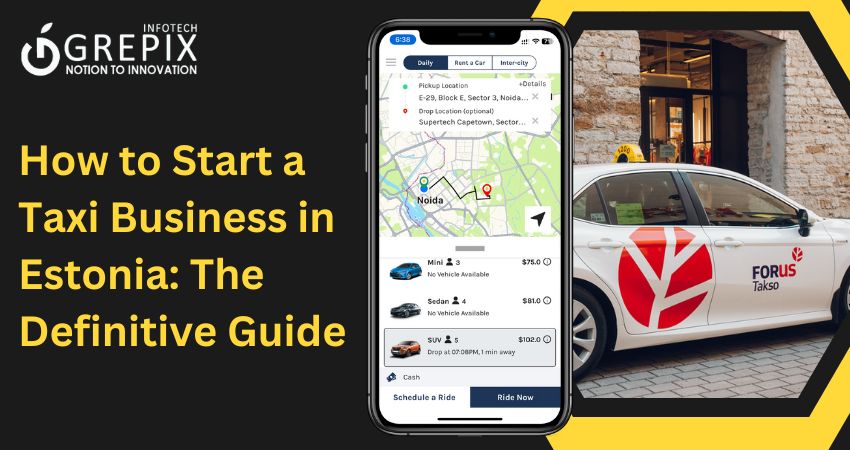How to Start a Taxi Business in Estonia: The Definitive Guide
Starting a taxi business in Estonia presents a promising opportunity, especially in a country known for its technological advancements and supportive business environment. By approaching the process strategically from understanding legal requirements to implementing effective marketing strategies you can establish a thriving and competitive taxi business.
Launching a taxi business in Estonia is a lucrative venture if approached strategically. By understanding legal requirements, leveraging technology, and implementing strong marketing and financial plans, you can build a successful and scalable business. Whether operating a traditional taxi service or launching a ride-hailing platform, Estonia’s digital economy and transportation demands provide ample growth opportunities. With the right approach, your taxi business can thrive in this competitive market. This comprehensive guide will walk you through every essential step.
Starting a taxi business in Estonia offers a promising opportunity, thanks to the country’s advanced digital infrastructure, supportive business environment, and growing demand for transportation services. A strategic approach covering legal requirements, financial planning, marketing, and leveraging technology can ensure long-term success. With a mix of traditional taxis and app-based ride-hailing platforms, Estonia provides ample space for innovation and business growth. By focusing on competitive pricing, high-quality service, and sustainability, entrepreneurs can carve out a niche in the industry. Whether launching a small taxi fleet or a tech-driven platform, Estonia’s transportation sector presents numerous profitable possibilities.
1Understanding the Taxi Industry in Estonia
Overview of the Taxi Market
Estonia’s taxi industry is a mix of traditional taxi services and modern ride-hailing platforms. Tallinn and Tartu serve as the primary hubs, with high demand for efficient transportation services. Estonia’s tech-driven population makes the market ideal for entrepreneurs looking to integrate digital solutions into their taxi services.
Growth and Trends in the Sector
The shift towards app-based taxi services has significantly transformed the industry. Companies like Bolt, based in Estonia, have set a precedent for tech-driven transport solutions. Additionally, the demand for eco-friendly taxis is growing, aligning with Estonia’s commitment to sustainability.
Why Estonia is an Ideal Location
The country’s advanced digital infrastructure, government support for startups, and a population that embraces new technology make Estonia a great place to launch a taxi business. Whether targeting tourists, corporate clients, or local commuters, there is a constant demand for reliable transportation services.
2Legal Requirements for Starting a Taxi Business in Estonia
Licensing and Permits
Taxi drivers in Estonia must obtain a specific taxi driver’s license, which includes passing a local knowledge exam, demonstrating language proficiency, and undergoing a background check.
Business Registration and Licensing
Register your taxi business with Estonia’s Commercial Register. You can operate as a sole proprietor or set up a private limited company (OÜ). Business registration is straightforward, especially with Estonia’s e-Residency program, allowing entrepreneurs to manage everything digitally.
Vehicle Standards
All taxis must meet strict safety and emissions requirements. Vehicles must pass regular inspections and adhere to transport regulations to obtain operating permits.
Insurance Requirements
Comprehensive insurance covering both drivers and passengers is mandatory. This protects your business against liabilities and ensures compliance with Estonian law.
Compliance with Estonia’s Transport Act
Following the Transport Act ensures transparency in pricing, fair competition, and adherence to safety regulations. This is especially important for businesses incorporating ride-hailing technology.
3Creating a Business Plan
Identifying Your Target Market
Defining your ideal customer base—whether tourists, corporate clients, or local commuters—will shape your business strategies and service offerings.
Setting Business Goals
Establish measurable goals such as revenue targets, fleet expansion plans, or customer acquisition benchmarks to guide your growth.
4Financial Planning and Budgeting
Initial Costs
Starting a taxi business involves expenses such as vehicle purchases, licensing fees, insurance, branding, and technology setup. A well-planned budget ensures a smooth launch without financial strain.
Ongoing Expenses
Regular operational costs include fuel, driver salaries, insurance premiums, and vehicle maintenance. Proper budgeting helps maintain profitability and ensures uninterrupted service.
Revenue Projections
Estimating earnings based on demand, pricing strategy, and fleet size allows for realistic financial planning. Analyzing market trends helps set achievable revenue targets.
Competitive Analysis
Assessing competitors like Bolt and Uber helps identify market gaps and opportunities. Offering unique services such as premium rides or eco-friendly taxis can help differentiate your business.
5Choosing the Right Fleet
New vs. Used Vehicles
New vehicles provide reliability and lower maintenance costs but require a higher upfront investment. Used taxis offer a more budget-friendly entry into the market with lower initial costs.
Eco-Friendly Taxi Options
Investing in electric or hybrid taxis reduces fuel expenses and aligns with Estonia’s sustainability goals. Government incentives may also help offset costs.
Prioritizing Comfort and Safety
Equipping taxis with air conditioning, spacious seating, and GPS tracking enhances customer satisfaction and safety, leading to repeat business.
6Leveraging Technology
Taxi Dispatch Software
A reliable dispatch system streamlines operations, reduces wait times, and improves overall efficiency, leading to better customer experience and higher earnings.
GPS and Navigation Tools
Advanced GPS technology helps drivers find the fastest routes, minimizing travel time, fuel costs, and delays. Real-time traffic updates further enhance efficiency.
Online Booking Platforms and Apps
Developing a custom taxi app or integrating with platforms like Bolt makes booking more accessible and convenient, expanding your customer base.
7Marketing Strategies
Building a Strong Brand Identity
A well-designed logo, catchy tagline, and consistent branding on social media platforms build credibility and recognition, helping your business stand out.
Digital Marketing
- Social Media: Platforms like Facebook and Instagram allow targeted promotions, customer engagement, and brand awareness, driving bookings and loyalty.
- SEO and Local Listings: Optimizing for keywords like "best taxi in Tallinn" and listing on Google My Business boosts visibility in search results, attracting more customers.
Partnering with Local Businesses
Collaborating with hotels, airports, and event organizers secures steady clientele and long-term corporate contracts, ensuring consistent revenue.
8Hiring and Training Drivers
Recruitment Best Practices
Hiring experienced and customer-friendly drivers ensures high service standards and enhances the reputation of your taxi business.
Training Programs
Providing comprehensive training on road safety, navigation tools, and customer service prepares drivers to offer excellent service.
Professionalism Standards
Implementing dress codes, punctuality rules, and regular performance evaluations helps maintain a professional and reliable service.
9Business Operations Management
Fleet Maintenance
Regular vehicle inspections and proactive maintenance prevent breakdowns, ensuring safety, efficiency, and compliance with regulations.
Customer Service Excellence
Encouraging feedback, addressing complaints promptly, and consistently delivering quality service helps build a loyal customer base.
Performance Monitoring
Tracking KPIs such as revenue per vehicle, customer ratings, and trip volume provides insights for improving operations and maximizing profitability.
Also Read: "2024 Guide to Top Taxi Apps in Estonia "
10Financial Management and Profitability
Managing Cash Flow
Using accounting software to monitor income and expenses ensures financial stability and helps manage operational costs effectively.
Pricing Strategies
Balancing affordability with profitability through competitive pricing, peak-hour surcharges, and special promotions optimizes revenue.
Revenue Growth Tactics
Introducing premium ride options, corporate transport packages, and customer loyalty programs can increase earnings and attract high-value clients.
11Overcoming Business Challenges
Competing with Rideshare Giants
Standing out from competitors like Bolt and Uber requires exceptional service, reliability, and unique offerings such as fixed pricing or luxury options.
Rising Fuel Costs
Switching to fuel-efficient or electric vehicles helps mitigate rising fuel expenses while supporting long-term sustainability.
Customer Expectation Management
Transparent pricing, real-time ride updates, and consistent service quality improve customer trust and satisfaction, leading to repeat business.
12Business Expansion Strategies
Fleet Expansion
Gradually increasing your fleet allows for controlled scaling, ensuring high service standards while meeting growing demand.
Premium Service Offerings
Luxury vehicles, VIP rides, and additional in-car features, such as Wi-Fi and refreshments, appeal to high-end customers and increase profitability.
Exploring New Markets
Expanding services beyond major cities to smaller towns and rural areas presents untapped opportunities with lower competition and steady demand.
Conclusion
Starting a taxi business in Estonia presents a lucrative opportunity, given the country's tech-savvy population, digital infrastructure, and supportive business environment. By following a well-planned strategy understanding legal requirements, developing a strong business plan, leveraging technology, and implementing effective marketing tactics you can establish a successful and scalable taxi operation.
Grepix Infotech, a leading taxi app development company, can help bring your vision to life by providing cutting-edge ride-hailing solutions tailored to your business needs. With expertise in developing feature-rich and user-friendly taxi apps, Grepix ensures seamless operations, improved efficiency, and a superior customer experience.
Whether you're launching a traditional taxi service or an innovative ride-hailing platform, Estonia’s dynamic transport landscape offers ample growth opportunities. By staying ahead of industry trends and utilizing smart business strategies, you can build a thriving and competitive taxi business that meets the demands of modern commuters.
FAQs
1. Do I need to be an Estonian citizen to start a taxi business in Estonia?
No, you don’t need to be a citizen. Estonia’s e-Residency program allows foreigners to set up and manage a business remotely.
2. What is the average startup cost for a taxi business in Estonia?
Costs vary depending on vehicle type, licensing fees, and marketing expenses, but a small-scale operation may require €10,000–€30,000.
3. What licenses are required to start a taxi business in Estonia?
You need a business registration and commercial vehicle permits. As required by the Transport Act, adhere to all legal requirements.
4. Are electric taxis a good investment in Estonia?
Yes, electric taxis benefit from lower fuel costs, government incentives, and increasing charging infrastructure.
5. How can I differentiate my taxi business from competitors?
Providing exceptional customer service, competitive pricing, using well-maintained vehicles, and integrating digital payment options can help you stand out.
Looking out to start your own venture like inDrive? Try out our HireMe Taxi inDriver Clone, the easiest way to kick-start your taxi business.








